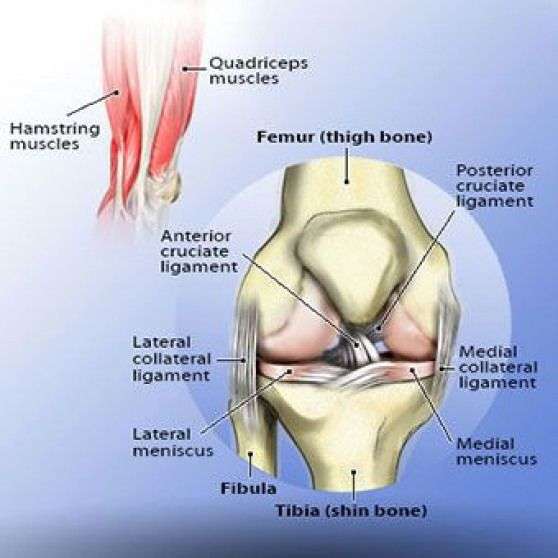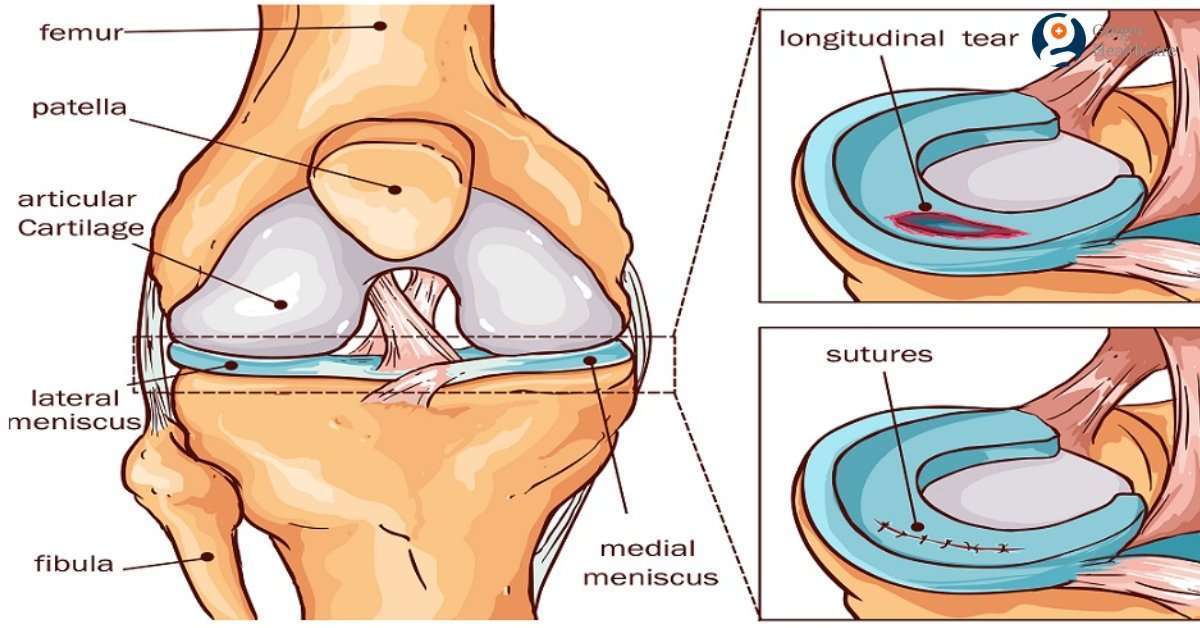Treatments For A Meniscal Tear Without Surgery
Basics Of Torn Meniscus
A torn meniscus is a tear in the cartilage of the knee. The meniscus functions to improve the fit between the femur and the tibia, to absorb shock and distribute load in the knee, and to help move lubricating fluid around the knee. The meniscus can tear from either trauma or injury or from degeneration.
The knee is made up of the femur , the tibia , and the patella . Ligaments hold the bones of the knee together and the patella lies in the quadriceps muscle in front of the knee.
Between the femur and the tibia are two pads, one on the medial side of the knee and one on the lateral side of the knee. Each of these pads is called a meniscus. See Figures 1 and 2.
The meniscus is made of fibrocartilage, which gives it a rubbery texture. Within the meniscus there are also fibers of collagen that help maintain the shape of the meniscus. The meniscus has blood supply only at its outer attachments. Therefore, about 4/5 of a meniscus has no blood supply and therefore cannot heal if it is torn.
Your Knees And Your Menisci
The knee is a hinge joint. If you imagine a door hinge, you know that it works via two-way movement, just as your knee can extend forward and bend back.
Every joint in your body is made up of bones, cartilage, ligaments, tendons, and other tissues and fluids. Inside the knee joint, the bottom of the thighbone meets the top of one of the lower leg bones , and they work together like a hinge. In the meantime, the kneecap glides along the bottom and front of the femur, protecting the knee and increasing the strength in your leg.
Inside the joint, cartilage helps the bones glide smoothly and also acts as a shock absorber when walking or running. The meniscus is actually a separate, thick pad of cartilage between the femur and the tibia, and each knee has two menisci one on the inside of the knee and one on the outer side.
The menisci play a very important function of protecting and stabilizing the joint and for smooth movement. If it is torn, your knee will be less stable and may feel like its not moving correctly. Other symptoms might include pain, swelling, popping, or locking.
Read Also: Dcf Knee Compression Sleeve
Surgery In Severe Cases
Certain meniscal tears require surgery, such as :
- Tears in the white zone of the meniscus.
- Meniscal tears associated with ACL tears.
- Frequent locking of the knee.
- Severe pain despite physical therapy, medication, and injections.
Sometimes your doctor and physical therapist may consider its in your best interest to undergo surgery.
The success of the surgery whether its meniscectomy, meniscal repair, or trimming depends on:
- What caused the tear in the first place the treatment wont be the same if its acute or degenerative.
- The place and size of the tear.
- Your age and lifestyle.
Undergoing any surgical treatment is a very personal decision. Talk with your surgeon and physical therapist about realistic outcomes according to your situation.
When Is Surgery Required For A Meniscus Tear

If the tear is minimal and on the outer part of the meniscus, physiotherapy can be the best treatment. You will be given a programme of exercises to build up the strength around your knee and improve mobility as the cartilage heals.
If the tear is more severe and you are very active or you have a physical job, surgery is usually recommended.
Read Also: How Much Does Aflac Pay For Ambulance Ride
What Does The Meniscus Do
The shape and size of the meniscus allows it to serve several functions. When you stand up, your weight is borne evenly through your legs and down to your knees. The stress this weight places on the knee becomes even higher while walking, running and jumping. The meniscus functions as cushion to keep the bones of the knee joint from grinding against one other and causing damage. It also transmits the load of your weigh evenly across the knee joint. This load-sharing helps to prevent knee injuries and is extremely important to the function and health of the knee.
An injury to the meniscus can affect the knees ability to function normally. The most common type of meniscus injury is a meniscal tear.
Can A Meniscus Tear Heal Itself Without Surgery
January 6, 2020 by Dr. Soffer
Generally speaking, the knee is a strong joint which can handle a lot. However, it isnt always the best at withstanding certain movements. Twisting, squatting and changing positions quickly can all put stress on the knee joint particularly on its wedge-shaped cartilage called the meniscus. If the strain is great enough, a meniscus tear may result. This can cause symptoms such as knee stiffness, swelling, pain and instability. Should this happen to you, you might wonder: Can a meniscus tear heal itself, or am I going to need surgery?
Read Also: How Much Does Aflac Pay For Outpatient Surgery
The Role Of Rehabilitation
Approximately 750,000 of knee meniscus surgeries are performed each year in the United States. Rehabilitation is a critical part of recovery. Physical rehabilitation programs following surgery typically include physical therapy exercises, which work to strengthen leg muscles for better support for your knee joint. For patients who undergo a partial meniscectomy, the recovery period is typically longer due to the time it takes for the cartilage tear to completely heal. Rehabilitation exercises have to be on hold until the cartilage has healed. It usually takes about three months to complete rehabilitation for a partial meniscectomy, whereas for a total meniscectomy, recovery is typically shorter.
What Is The Prognosis For People With A Torn Meniscus
Most people who tear a meniscus can return to full activity. If you have surgery to repair a torn meniscus, your knee should be fully recovered after a few months of physical therapy.
If you have surgery to remove all or part of your meniscus, you may be at higher risk of developing arthritis down the road. Thats because you now have less shock absorption in your joint. Over time, the joint can break down.
Don’t Miss: Inversion Table Knees
Is A Torn Meniscus A Permanent Injury
Permanence of menisci injuries depend on where theyre located.
- Single-trauma injuries to the outer third can heal because it has sufficient blood supply.
- The inner third , however, will not because of the lack of circulation.
- The middle third zone can heal but it might not fully recover or take a while longer.
Damage to the inner and middle thirds of the meniscus may require surgery to reduce joint pain and swelling. Surgical options include repair or removal of all or part of the cartilage .
Degenerative meniscus tears also wont heal naturally and may develop into arthritis with age. If youre unsure, I highly recommend seeking a professionals medical advice.
Question 1 Of : Can A Meniscus Tear Heal On Its Own
Read Also: How To Whiten Knees Fast
New Technology On The Horizon
In the United States, there is ongoing research in to the use of meniscal allograft surgery where a meniscus donated from a deceased person is used to replace the injured meniscus. The results for this procedure are promising but it is not available in Australia and is unlikely to be a treatment option in the near future due to a lack of availability of donor menisci.
Surgery For A Torn Meniscus

For meniscal tears that dont receive good blood supply or are particularly severe injuries, surgery is often required for correction. Surgery for a torn meniscus can now be completed through minimally-invasive arthroscopic surgery. This method is aptly called either arthroscopic knee meniscus repair or an arthroscopic meniscectomy. During the procedure, a surgeon repairs the torn meniscus using an arthroscope and miniature surgical tools. A part of the meniscus may need to be removed as part of the procedure if it is damaged beyond repair.
Also Check: Inversion Table For Knee Pain
Treating A Meniscus Tear
The recommended treatment for a torn meniscus will depend on the severity of your meniscal tear and its exact location. If the tear is located in the part of the cartilage thats receiving good blood supply, it can be treated non-surgically. When there is good blood supply, the area will have access to oxygen as well as healthy nutrients and components, all of which are necessary for healing. Because of this, areas that lack good blood flow can be trickier to treat through nonsurgical means. Conservative treatments like RICE rest, ice, compression, and elevation are typically enough to heal minor to moderate meniscal tears in areas with good blood supply. You can also take anti-inflammatories for swelling and pain.
How About A Third Opinion On This What Is The Failure Rate After Arthroscopic Repair Of Bucket
A June 2021 paper in The American Journal of Sports Medicine explored a determination of patient failure rate after arthroscopic repair of Bucket-Handle Meniscal Tears. To make this determination doctors compared bucket-handle meniscal tears with the failure rate of simple meniscal tears extracted from the same studies, and analyze the influence of factors previously reported to be predictive of meniscal repair failure.
In other words, the doctors examined previous research in which meniscus tear failure rates were compiled. They also looked for research where a simple meniscus repair was performed to assess its failure rate against the bucket handle tear.
Results: The pooled failure rate was 14.8% . Bucket handle meniscus tears failure rates were significantly higher. Medial bucket-handle meniscus tear repairs and isolated repairs had a statistically higher risk of failure, but no statistically significant difference was found between tears in red-red versus red-white zones. Based on the currently available literature, this systematic review provides a reasonably comprehensive analysis of failure rate after arthroscopic BHMT repair failure is estimated to occur in 14.8% of cases. Medial tears and isolated repairs were the 2 major predictors of failure.
Recommended Reading: Cellulite Above Knees
How To Heal Your Torn Meniscus Naturally Without Surgery
I have had a number of knee injuries from sports and tore my meniscus two times in BJJ. I didnt do surgery on it because all of my research suggested that it was a risky move.
So I took natural, alternative and some definitely non-mainstream approaches to healing and treating it.
So I put some of that research here and a ton on a site I made called Healiscus.DISCLAIMER: I am not a doctor and even if I was you shouldnt believe everything I say. You have to do ample research to determine the best course of action for you.
Now
In this post first Ill focus on the studies and outcomes surrounding meniscus tear surgeries. Then towards the end Ill touch on some treatment tips and theres an FAQ too.
If you are a big thinker and you want to heal your meniscus so you can get back to your game then this is probably for you.
Or if you are considering surgery I think this will definitely help.
Does Meniscus Surgery Work
If your meniscus wont heal or at least if your knee pain doesnt go away, do we know that surgery will work? After all, meniscus surgery is one of the most common orthopedic procedures performed today. The answer for the most common type of surgery called arthroscopic partial meniscectomy is a firm no. How can that be? Lets review.
We have three very high-level studies that show that no matter whats wrong with your knee , the surgery is no better than a fake procedure or physical therapy . Many surgeons will argue that these studies only looked at the responses of large groups of people and that they are better at picking who will respond.
However, we now have newer research that shows that there is no identifiable sub-group of patients who will respond to APM .
In fact, were starting to see that the removal of the torn part of the meniscus that occurs in APM may cause more arthritis . Why? The procedure likely increases the forces on the cartilage by removing parts of that meniscus spacer, which likely still has some protective effect even when torn.
Don’t Miss: Does Tommie Copper Knee Sleeve Work
Help The Meniscus Tear Heal
Some braces can restrict flexion as well. This is imperative after certain surgeries so the ligaments can heal properly.Your doctor can change the degrees of restriction according to your recovery process.
Conversely, an unloader brace can help the tear heal by reducing pressure.
A brace can also aid in your recovery by increasing your confidence which is crucial!
Some people fear moving their knees or doing certain exercises. But, this is a central part of the rehabilitation process.
A brace may help you feel more confident. And, in turn, make you better able to do your therapy exercises at the beginning of the recovery process.
Eventually, youll be able to do them without the garment.
What Causes A Meniscus Tear
Most often, the meniscus tears during a sudden motion in which your knee twists while your foot stays planted on the ground. The tear frequently occurs while playing sports. People whose cartilage wears down can tear a meniscus from a motion as simple as stepping on an uneven surface. Sometimes, degeneration from arthritis causes a tear, even without a knee injury.
Read Also: Ginger Poultice For Knee Pain
Treatments For A Torn Meniscus
A meniscus tear is a common knee injury most often incurred while playing sports or exercising. Athletes, professional and amateur, and those who are highly physically active are particularly suspectable.
The knee meniscus is C-shaped cartilage located between the shinbone and the thighbone. You can tear it through a forceful twisting motion of the knee or by kneeling for extended periods of time and doing heavy lifting. Athletes who play basketball, soccer, football, and hockey have a significant risk of this injury because they often have to suddenly twist and change directions when playing. This injury is especially high-risk for those who play sports strenuously or dont condition well.
If you feel like your knee is giving out or your range of motion has been limited, you could have a minor tear in your meniscus. A torn meniscus may be confused with an ACL tear because symptoms can overlap. Only an orthopedic specialist can diagnose you correctly and recommend the appropriate treatment.
Meniscus Tear Exercise : Improve The Strength Of Your Leg Muscles

The first meniscus tear exercise focuses on improving the strength of your leg muscles. When your leg muscles become stronger, the pressure on your knee and meniscus reduces. The exercise design ensures that you can train your leg muscles without putting too much pressure on your meniscus.
Perform the exercise like this:
- Lay down on your back
- Pull your toes towards you and keep your knee extended
- Now lift your leg ten times without rest
- Repeat this three times
- Do this for both legs
You can also see how to perform the exercise correctly on this youtube video.
You will notice that your injured leg feels much weaker when you perform the exercise than your healthy leg. As you do the exercise more often, youll see that this difference disappears. Thats also when the knee pain starts to wear off.
As the exercise gets easier, you can lift your leg 15 or even 20 times to improve your strength even more.
Read Also: How To Get Rid Of Knee Fat And Cellulite
Can A Meniscus Tear Heal On Its Own Without Surgery
In the case of meniscus tears, some people think the injury will heal over time on its own. But the truth is that there are different types of meniscus tears and some tears wont heal without treatment. If your tear is on the outer one-third of the meniscus, it may heal on its own or be repaired surgically.